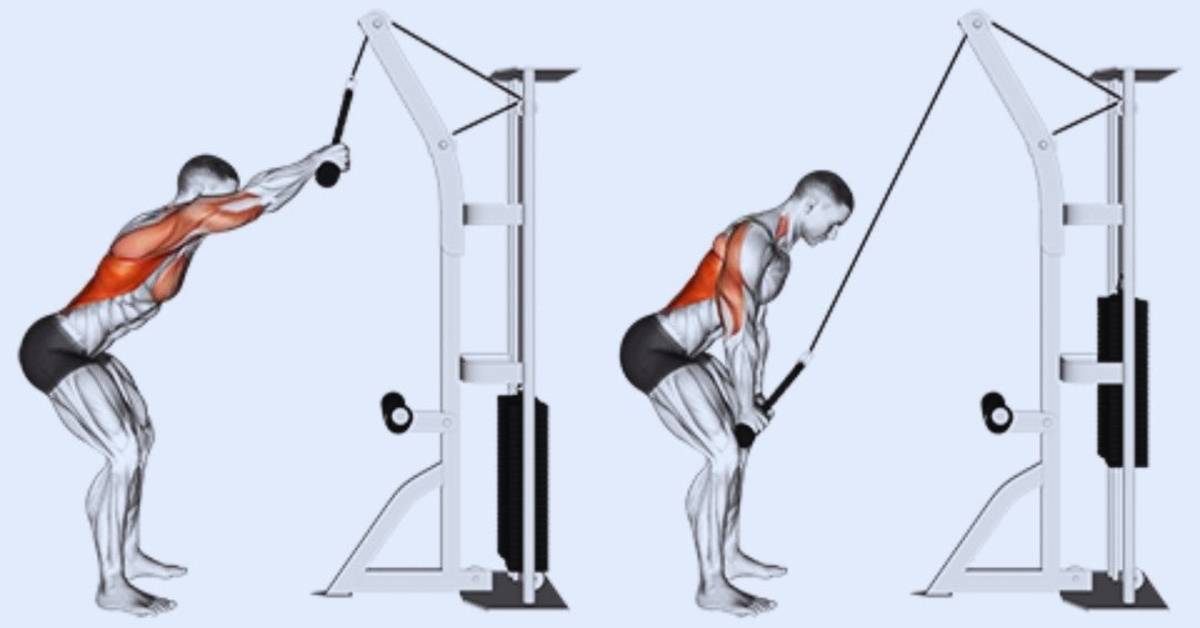A kneeling cable pullover is a great exercise to target the lats, which are major muscles in your back. This exercise will help to strengthen and build the lats, increasing definition and helping you create a more impressive upper body. It is also great for posture as it helps to keep your spine in proper alignment. It is a challenging move, but it’s worth mastering because the results are impressive.
Cable Pullovers Muscles Worked
Cable pullovers are versatile and effective exercise that primarily targets the muscles in the upper body. By incorporating this exercise into your fitness routine, you can engage multiple muscle groups simultaneously, promoting strength, stability, and overall upper body development.
Latissimus Dorsi (Lats)
The latissimus dorsi, or simply the “lats,” are the largest muscles in the back and play a significant role in cable pullovers. As you pull the cable down and back towards your thighs, the lats are intensely engaged to generate the primary pulling force. Developing strong lats contributes to a wide and well-defined back, enhancing both aesthetics and functional strength.
Pectoralis Major (Pecs)
The pectoralis major muscles, commonly referred to as the “pecs,” are located in the chest region. During cable pullovers, the pecs act as synergistic muscles, assisting the lats in the pulling motion. This exercise provides an excellent opportunity to engage and strengthen the pecs, helping to enhance chest size and definition.
Deltoids (Delts)
The deltoid muscles, or delts, are located in the shoulder region and comprise three heads: anterior (front), medial (side), and posterior (rear). Cable pullovers primarily target the posterior deltoids, which are responsible for shoulder extension and adduction. Strengthening the deltoids not only improves shoulder stability but also enhances overall upper body symmetry and aesthetics.
Triceps Brachii
The triceps brachii, commonly known as the triceps, are located at the back of the upper arm. During cable pullovers, the triceps are actively engaged as they assist in extending the elbow joint during the pulling motion. This exercise provides a unique opportunity to target and strengthen the triceps, promoting arm strength and definition.
Rhomboids and Trapezius
The rhomboids and trapezius muscles, located in the upper back region, are also involved in cable pullovers. These muscles work synergistically with the lats to stabilize and retract the scapulae (shoulder blades) during the pulling motion. Strengthening these muscles contributes to better posture, improved upper back strength, and reduced risk of shoulder injuries.
Core
Additionally, cable pullovers also engage and target the core muscles, although to a lesser extent compared to the primary muscle groups mentioned earlier. While the core muscles may not be the primary focus of cable pullovers, they play a crucial role in providing stability and support during exercise.
The core muscles, including the rectus abdominis, obliques, and transverse abdominis, work to stabilize the spine and maintain proper posture throughout the movement. As you perform cable pullovers, your core muscles are activated to resist the rotational forces and maintain a stable position. This engagement of the core helps improve overall body control and balance.
Read Also: Lat Pullover: How to, Muscles Worked, Mistakes, Variations, Alternatives
How to Do Kneeling Straight Arm Cable Pullover Perfectly?
- Start by kneeling in front of a low pulley cable machine and attaching a rope handle to the bottom pulley.
- Position yourself so you are kneeling on both knees, with your head and chest up, back straight, and core tight
- Grasping the handles in each hand, keep your arms straight out in front of you, and draw your shoulder blades together.
- Inhale and slowly pull the rope toward you in an arcing motion until it is above your head. Keep your arms straight during this part of the movement.
- Exhale as you return to the starting position using a slow, steady motion and feeling your back muscles working throughout.
- Repeat for desired reps and sets, making sure to keep good form during each repetition.
- Repeat this exercise 8 – 12 times for 3.
Important Tips While Performing Cable Pullovers
Cable pullovers are an effective exercise for targeting the upper body muscles and engaging the core. To ensure that you perform cable pullovers correctly and maximize their benefits, follow these helpful tips:
Set Up Properly
- Adjust the height of the cable pulley so that it aligns with your chest or slightly above.
- Stand with your feet shoulder-width apart and maintain a stable stance throughout the exercise.
Choose the Right Attachment
- Select a handle or attachment that allows for a comfortable grip and proper wrist alignment.
- Experiment with different attachments to find the one that suits your hand size and preferences.
Maintain Proper Form
- Start by grabbing the handle with an overhand grip, palms facing down.
- Position yourself with a slight forward lean, maintaining a neutral spine and engaged core.
- Keep your elbows slightly bent and your shoulders relaxed throughout the movement.
Focus on the Stretch and Contraction
- Initiate the movement by slowly pulling the cable handle down and behind your body, emphasizing the stretch in your target muscles.
- Pause for a moment at the end of the range of motion, feeling the stretch and maintaining control.
Engage the Target Muscles
- Focus on engaging the target muscles (such as the latissimus dorsi) throughout the entire exercise.
- Imagine squeezing your back muscles as you bring the cable handle forward to emphasize the contraction.
Control the Weight
- Start with a weight that allows you to maintain proper form and perform the exercise with control.
- Once you are comfortable and confident with the movement, gradually increase the weight.
Breathe Properly
- Inhale during the stretching phase as you pull the cable handle back.
- Exhale as you bring the handle forward, focusing on contracting the target muscles.
Avoid Swinging or Jerking Motions
- Throughout the exercise, keep your motion smooth and controlled.
- Avoid using momentum or excessive swinging to lift the weight, as this reduces the effectiveness and increases the risk of injury.
Include Variations
- Explore different cable pullover variations, such as single-arm pullovers or kneeling pullovers, to target your muscles from different angles and challenge your body in new ways.
Seek Professional Guidance
- If you are new to cable pullovers or unsure about your form, consider seeking guidance from a certified fitness professional who can provide personalized instruction and ensure you are performing the exercise correctly.
Must Read: Cable Rope Pullover, How to, Muscles Worked, Alternatives
Common Mistakes to Avoid
Cable pullovers are an effective exercise for targeting the upper body muscles, but like any exercise, they can be performed incorrectly, leading to suboptimal results or even potential injuries. To help you get the most out of your cable pullover workouts, here are some common mistakes to avoid:
Using Excessive Weight
One of the most common mistakes is using too much weight, compromising form and technique. It’s important to start with a weight that allows you to maintain proper form throughout the exercise. Gradually increase the weight as your strength and technique improve to avoid strain and potential injury.
Poor Posture and Spinal Alignment
Incorrect posture and spinal alignment during cable pullovers can put unnecessary stress on the back and lead to discomfort or injury. Avoid rounding your shoulders or hunching forward. Instead, maintain an upright position with your chest lifted, shoulders back, and a neutral spine throughout the movement.
Insufficient Range of Motion
Failing to achieve a full range of motion is another common mistake. Many individuals perform cable pullovers with limited motion, missing out on the full benefits of the exercise. Make sure to fully stretch your arms and engage your back muscles as you pull the cable down and behind your body, maximizing the exercise’s effectiveness.
Using Momentum Instead of Control
Swinging or using momentum to move the weight during cable pullovers is a common error. This reduces the effectiveness of the exercise and puts unnecessary strain on the joints. Focus on using controlled movements and avoid relying on momentum to complete the repetitions. Engage the targeted muscles throughout the entire range of motion.
Neglecting Core Engagement
A common mistake is neglecting to engage the core muscles during cable pullovers. Failing to stabilize the core can result in a loss of balance and compromised form. Remember to activate your core muscles by bracing your abdominals and maintaining a stable torso throughout the exercise.
Incorrect Grip Placement
Placing your hands too close or too wide on the cable attachment can affect the targeted muscle engagement and form. To optimize the exercise, position your hands at a comfortable width, allowing for a natural range of motion while maintaining proper form. Find out what works for you by experimenting with different grip variations.
Not Breathing Properly
Breathing is often overlooked during cable pullovers. Holding your breath or not breathing properly can lead to increased tension and reduced performance. Remember to exhale as you pull the cable down and inhale as you return to the starting position. This rhythmic breathing helps maintain a steady flow of oxygen to the muscles.
Lack of Warm-up and Stretching
Neglecting a proper warm-up and stretching routine before cable pullovers can increase the risk of muscle strains or injuries. Prioritize a dynamic warm-up to prepare the muscles and joints for the exercise. Additionally, include stretches that target the back, chest, and shoulders to improve flexibility and range of motion.
Overtraining and Neglecting Rest
Overtraining the same muscle groups without allowing sufficient rest and recovery can hinder progress and increase the risk of overuse injuries. Avoid performing cable pullovers or any exercise that targets the same muscles on consecutive days. Give your muscles time to recover and adapt to the stress of the workout.
Lack of Proper Instruction or Supervision
Performing cable pullovers without proper instruction or supervision can lead to poor technique and potential injuries. If you’re new to this exercise, seek guidance from a qualified fitness professional who can teach you the correct form, provide feedback, and ensure your safety.
Benefits of Cable Pullovers
Cable pullovers are a versatile exercise that offers numerous benefits for individuals looking to strengthen their upper body and improve their overall fitness. Incorporating cable pullovers into your workout routine can provide the following advantages:
Target Multiple Muscle Groups
Cable pullovers primarily target the latissimus dorsi, the large muscles of the back responsible for a wide and powerful upper body. Additionally, this exercise engages other muscles, including the chest, shoulders, and triceps, promoting overall upper-body strength and development.
Improved Upper Body Strength
Cable pullovers involve a pulling motion that requires substantial upper-body strength. By regularly performing this exercise, you can increase the strength and endurance of your back, chest, and shoulder muscles, leading to improved functional strength for everyday activities and other exercises.
Increased Muscular Definition
The combination of targeting multiple muscle groups and the stretching and contracting involved in cable pullovers can contribute to increased muscular definition and sculpting. With consistent training, you can develop a more toned and chiseled upper body appearance.
Enhanced Posture
Strong back muscles are crucial for maintaining proper posture and spinal alignment. Cable pullovers strengthen the muscles that support the spine, helping to improve posture and reduce the risk of developing postural imbalances or back pain caused by poor posture.
Core Engagement
Cable pullovers require core stability and engagement to maintain proper form and balance during the exercise. As you pull the cable handle down and behind your body, your core muscles, including the abdominals and obliques, work to stabilize your torso. This added core engagement contributes to improved core strength and stability.
Increased Range of Motion
Cable pullovers involve a deep stretch in the back muscles, particularly during the eccentric phase of the exercise. This stretching motion helps increase your range of motion in the shoulder joint and upper back, enhancing flexibility and overall mobility.
Improved Functionality
Cable pullovers mimic movements involved in various daily activities and sports, such as lifting, pulling, and reaching. By strengthening the muscles used in these functional movements, you can improve your overall physical performance and make everyday tasks feel easier.
Versatility and Variation
Cable pullovers offer versatility through different attachments, grip variations, and exercise modifications. You can target different angles and muscle groups by adjusting your grip width, using single-arm variations, or performing kneeling pullovers. This versatility allows for a more well-rounded upper body workout and prevents plateaus in your training.
Injury Prevention
Strengthening the back muscles through cable pullovers can contribute to injury prevention. Strong back muscles provide better support and stability to the spine, reducing the risk of back injuries during physical activities or heavy lifting.
Mental Focus and Mind-Muscle Connection
Performing cable pullovers requires concentration and focus to execute the movement correctly. By practicing this exercise, you can develop a stronger mind-muscle connection, enhancing your ability to engage and activate the targeted muscles effectively.
Cable Pullover Variations and Alternative
Cable pullovers are a great exercise for targeting the upper body muscles, specifically the back, chest, and shoulders. However, adding variations and alternatives to your workout routine can help keep it interesting, challenge different muscle groups, and provide a well-rounded training stimulus. Here are some cable pullover variations and alternatives along with instructions on how to perform them:
Wide Grip Cable Pullover
- Attach a straight bar or a wide-grip handle to the high pulley of a cable machine.
- Your feet should be shoulder-width apart and your knees slightly bent while facing the cable machine.
- Grasp the bar or handle with a wide overhand grip.
- Keeping your arms straight, pull the bar or handle down and behind your head until you feel a stretch in your chest and shoulders.
- Reverse the movement slowly to return to the starting position.
- Repeat for the desired number of repetitions.
Reverse Grip Cable Pullover
- Attach a straight bar or a close-grip handle to the high pulley of a cable machine.
- As you face away from the cable machine, place your feet shoulder-width apart and bend your knees slightly as you stand.
- Grasp the bar or handle with a reverse or underhand grip.
- With your arms straight, pull the bar or handle down and in front of your body, focusing on engaging your upper back muscles.
- Slowly return to the starting position by reversing the movement.
- Perform the desired number of repetitions.
One-Arm Cable Pullover
- Attach a single-hand grip handle to the high pulley of a cable machine.
- Stand perpendicular to the cable machine with your feet shoulder-width apart and knees slightly bent.
- Grasp the handle with one hand and extend your arm straight out to the side.
- Keeping your arm straight, pull the handle down and across your body, rotating slightly through your torso.
- Slowly return to the starting position while maintaining control.
- Repeat on the other side for a balanced workout.
Dumbbell Pullover
- Lie with your upper back supported on a bench and your feet planted firmly on the ground.
- Hold a dumbbell with both hands, palms facing upward, and arms extended straight above your chest.
- Lower the dumbbell in an arc behind your head while keeping your arms straight.
- Pause when you feel a stretch in your chest and shoulders.
- Lift the dumbbell back to the starting position, engaging your chest and back muscles.
- Repeat for the desired number of repetitions.
Resistance Band Pullover
- Anchor a resistance band securely to a sturdy object at chest level.
- Stand facing away from the anchor point and hold the band with both hands.
- Begin with your arms extended straight in front of your body.
- Pull the band down and behind your head in an arc, maintaining tension throughout.
- Slowly return to the starting position by reversing the movement.
- Perform the desired number of repetitions.
Machine Pullover
- Sit facing the padded backrest of a machine pullover station.
- Adjust the seat and the handles to align with your chest level.
- Grasp the handles with an overhand grip and keep your elbows slightly bent.
- Pull the handles toward your body in a sweeping motion, focusing on contracting your back muscles.
- Slowly release the handles and return to the starting position.
- Repeat for the desired number of repetitions.









